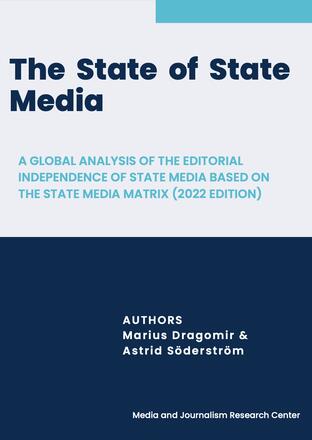
The study examines the independence of public media in 157 countries throughout 2022. To go beyond the dichotomy of state-controlled outlet vs independent public service media, the authors of the study developed a methodology labelled the State Media Matrix. The State Media Matrix analyses three key factors: funding, ownership/governance and editorial autonomy. Relying on this matrix, the report has identified seven typologies of State Media, with “Independent Public Media” and “State Controlled Media” at opposite extremities.
Globally, in 2022 the governmental control over state media has been extremely high. Around 84% of the 595 state-administered media have been lacking independence. Many countries saw an erosion of the independence of public media services. Most of these countries are located in Asia or in the MENA region, where state-controlled media accounts respectively for 74% and 63% of public-owned outlets. According to the study, there are no independent public media outlets in Eurasia, sub-Saharan Africa, Latin America and the MENA region. Just 16% of the 595 state media under evaluation have editorial independence, and just 19 are considered to be fully independent.
Out of 19, 12 independent outlets are located in Europe. As far as the European continent, the study reported a slight decline of fully and partially independent media outlets. While in 2021 they accounted for 54%, in 2022, they dropped to 50%. In addition, 29 media outlets, which are listed under the independent state-funded and state-managed categories, are at risk of sliding into the state-controlled typology of the State Media Matrix. Independent state media face risks in Central and Northern Europe. Slovenia, Denmark, and Austria have experienced governmental interference from right-wing parties. Most European private captured media outlets (21 out of 32) have ties with governments, supporting their agendas. The number of these private captured media outlets is rising and in some cases they risk to fall under the category of state-controlled media, following the lead of Poland, Hungary, and Turkey. Governmental interference has led to the increase of captured media outlets in Spain and Slovenia. Eastern Europe is home to more than 86% of state-owned and state-captured media of the whole continent. Most Eastern European countries still need to implement reforms aimed at mitigating governments’ interference in the management of the media system. Southern Europe also raises some concerns, having most of the state media under the control of the government. Few independent news broadcasters can be found in Cyprus, Greece, and Portugal.
The situation in Eurasia is alarming. Almost all (97%) of state media are editorially controlled by the government. Russian influence, especially after the invasion of Ukraine, is spreading throughout the adjacent region. In order to promote the Russian narrative of the war, Russia has built secret foreign-oriented operations. It is hard to detect Russia-controlled media outlets outside of Russia. In the Eurasia region, almost all the public media not controlled by the government are owned by oligarchs who have ties with politicians. Just two public media outlets in Ukraine and Moldova are editorially independent.
Tags: Rule of Law Media ownership Media capture Media fundingThe content of this article can be used according to the terms of Creative Commons: Attribution-NonCommercial 4.0 International (CC BY-NC 4.0) . To do so use the the wording "this article was originally published on the Resource Centre on Media Freedom in Europe" including a direct active link to the original article page.

